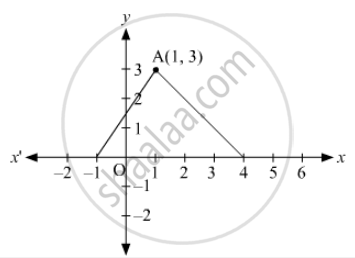Advertisements
Advertisements
प्रश्न
Points P, Q, R and S divides the line segment joining A(1, 2) and B(6, 7) in 5 equal parts. Find the coordinates of the points P, Q and R.
उत्तर

It is given that P, Q, R and S divides the line segment joining A(1, 2) and B(6, 7) in 5 equal parts.
∴ AP = PQ = QR = RS = SB .....(1)
Now,
AP + PQ + QR + RS + SB = AB
⇒ AP + AP + AP + AP + AP = AB [From (1)]
⇒ 5AP = AB
⇒ AP = \[\frac{1}{5}\] AB .....(2)
Now,
PB = PQ + QR + RS + SB = \[\frac{1}{5}\] AB + \[\frac{1}{5}\] AB + \[\frac{1}{5}\] AB + \[\frac{1}{5}\] AB = \[\frac{4}{5}\] AB .....(3)
From (2) and (3), we get
AP : PB = \[\frac{1}{5}\] AB : \[\frac{4}{5}\] AB = 1 : 4
Similarly,
AQ : QB = 2 : 3 and AR : RB = 3 : 2
Using section formula, we get
Coordinates of P = \[\left( \frac{1 \times 6 + 4 \times 1}{1 + 4}, \frac{1 \times 7 + 4 \times 2}{1 + 4} \right) = \left( \frac{10}{5}, \frac{15}{5} \right) = \left( 2, 3 \right)\]
Coordinates of Q = \[\left( \frac{2 \times 6 + 3 \times 1}{2 + 3}, \frac{2 \times 7 + 3 \times 2}{2 + 3} \right) = \left( \frac{15}{5}, \frac{20}{5} \right) = \left( 3, 4 \right)\]
Coordinates of R = \[\left( \frac{3 \times 6 + 2 \times 1}{3 + 2}, \frac{3 \times 7 + 2 \times 2}{3 + 2} \right) = \left( \frac{20}{5}, \frac{25}{5} \right) = \left( 4, 5 \right)\]
APPEARS IN
संबंधित प्रश्न
Find the distance between the following pair of points:
(a, 0) and (0, b)
If (−2, 3), (4, −3) and (4, 5) are the mid-points of the sides of a triangle, find the coordinates of its centroid.
Find a point on y-axis which is equidistant from the points (5, -2) and (-3, 2).
Show that the following points are the vertices of a square:
A (6,2), B(2,1), C(1,5) and D(5,6)
A point whose abscissa and ordinate are 2 and −5 respectively, lies in
Points (−4, 0) and (7, 0) lie
The points \[A \left( x_1 , y_1 \right) , B\left( x_2 , y_2 \right) , C\left( x_3 , y_3 \right)\] are the vertices of ΔABC .
(i) The median from A meets BC at D . Find the coordinates of the point D.
(ii) Find the coordinates of the point P on AD such that AP : PD = 2 : 1.
(iii) Find the points of coordinates Q and R on medians BE and CF respectively such thatBQ : QE = 2 : 1 and CR : RF = 2 : 1.
(iv) What are the coordinates of the centropid of the triangle ABC ?
If \[D\left( - \frac{1}{5}, \frac{5}{2} \right), E(7, 3) \text{ and } F\left( \frac{7}{2}, \frac{7}{2} \right)\] are the mid-points of sides of \[∆ ABC\] , find the area of \[∆ ABC\] .
If the centroid of the triangle formed by points P (a, b), Q(b, c) and R (c, a) is at the origin, what is the value of a + b + c?
If the mid-point of the segment joining A (x, y + 1) and B (x + 1, y + 2) is C \[\left( \frac{3}{2}, \frac{5}{2} \right)\] , find x, y.
Find the values of x for which the distance between the point P(2, −3), and Q (x, 5) is 10.
Find the area of triangle with vertices ( a, b+c) , (b, c+a) and (c, a+b).
The distance between the points (cos θ, 0) and (sin θ − cos θ) is
If the points (k, 2k), (3k, 3k) and (3, 1) are collinear, then k
If the points P (x, y) is equidistant from A (5, 1) and B (−1, 5), then
The ratio in which the line segment joining points A (a1, b1) and B (a2, b2) is divided by y-axis is
In Fig. 14.46, the area of ΔABC (in square units) is

Find the point on the y-axis which is equidistant from the points (S, - 2) and (- 3, 2).
Write the equations of the x-axis and y-axis.
Co-ordinates of origin are ______.
